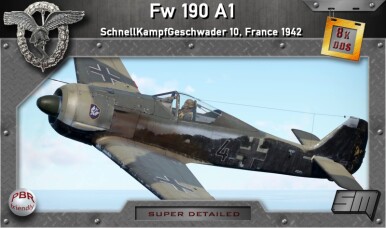



The Focke-Wulf Fw 190 Würger (Shrike) was a single-seat, single-engine monoplane fighter used by the Luftwaffe in WWII. One of the best fighters of the time, it was widely used during the Second World War. A total of over 20,000 were produced, including some 6,000 fighter-bomber variants. The Fw 190 remained in production from 1941 until the end of the war, going through multiple redesigns. The Fw 190 made a name for itself as a true Luftwaffe workhorse and was used in a wide variety of roles, including high-altitude interception (especially the Fw 190 D), escort, fighter-bombing and night fighting. The officially designated nickname "Würger" denotes a kind of carnivorous bird (a shrike), but can also be translated as choker, or strangler. In that regard, it fits the contemporary English designation well, too: "Butcher-bird".
Introduced in Update 1.39, the Fw 190 A-1, as all the planes in this line, are some of the best Boom and Zoomers in the game and should be flown exclusively in this style. The performance at high speeds is excellent, as are their dive and zoom characteristics. Do not ever engage in a turnfight as a "furball" with superior turners such as the A6M2 will end badly. Instead, fight mainly in the vertical. Try to have an altitude, or speed, advantage over your opponents (by climbing to the side at the start of the battle and then enter the highest battle you see). It is still possible to subdue your opponent with the A-1 due to the fantastic roll rate of the "Würger".
Unlike the later 190 line (A-8 and up), the A-1 through A-5 all possess higher turn capabilities than the rest of the line. The A-1 can, in general, out turn less manoeuvrable planes such as the LaGG-3. However, it is still not recommended to get into turnfights, as the A-1 will be placed with many better-manoeuvring fighters like the Spitfire.
flaps
flaps
flaps
brake
| Belt | Belt filling | Armor penetration (mm) at a distance: | |||||
|---|---|---|---|---|---|---|---|
| 10 m | 100 m | 500 m | 1000 m | 1500 m | 2000 m | ||
| IT/HEI/APHE | 19 | 18 | 15 | 10 | 3 | 3 | |
| IT/HEI/HEI/APHE | 19 | 18 | 15 | 10 | 3 | 3 | |
| FI-T/HEI/HEI/FI-T/HEI/HEI/APHE | 19 | 18 | 15 | 10 | 3 | 3 | |
| IT | 10 | 10 | 5 | 2 | 1 | 1 | |
| APHE/HEI/HEI/HEI/AP-I | 20 | 17 | 10 | 5 | 3 | 2 | |
| Belt | Belt filling | Armor penetration (mm) at a distance: | |||||
|---|---|---|---|---|---|---|---|
| 10 m | 100 m | 500 m | 1000 m | 1500 m | 2000 m | ||
| AP-T/AP-I/AI | 9 | 8 | 6 | 3 | 0 | 0 | |
| AP-T/AP/AI/AP-I | 13 | 12 | 7 | 3 | 2 | 0 | |
| AP-T | 9 | 8 | 6 | 3 | 0 | 0 | |
| AI/AP/AP/AP/AI | 13 | 12 | 7 | 3 | 2 | 0 | |












Flight performance | |
|---|---|
Survivability |
|---|
Weaponry |
|---|
